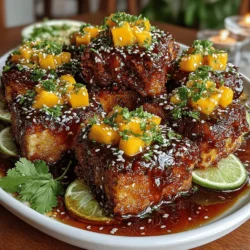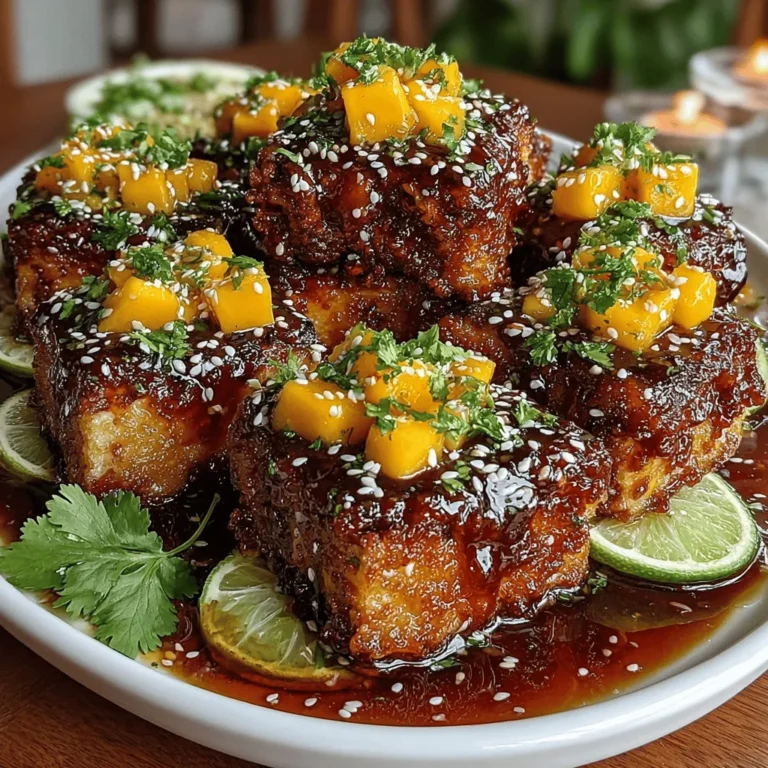Mango Tango Tofu: A Plant-Based Delight
In recent years, plant-based meals have surged in popularity, capturing the attention of health enthusiasts and culinary adventurers alike. As more individuals seek to incorporate nutritious and sustainable ingredients into their diets, the demand for creative and delicious vegetarian dishes has never been higher. Among these vibrant options, Mango Tango Tofu stands out as a delightful fusion of flavors that harmoniously blends the natural sweetness of ripe mango with the savory richness of tofu. This dish not only tantalizes the taste buds but also offers a plethora of health benefits, making it a perfect choice for both vegetarians and meat-eaters.
Mango Tango Tofu is not merely a meal; it is an experience that showcases the versatility of plant-based cooking. The combination of textures and flavors creates a dish that is as visually appealing as it is delicious. Whether you are looking to impress guests at a dinner party or simply want to enjoy a healthy and satisfying meal at home, this recipe is sure to become a favorite in your kitchen.
Understanding Tofu: The Versatile Protein Source
Tofu, often referred to as bean curd, is a fundamental ingredient in many plant-based diets. Made from soybeans, tofu is a protein-rich food that is low in calories and offers a wide range of health benefits. Its high protein content makes it an excellent alternative to meat, providing essential amino acids that are vital for the body’s growth and repair.
When it comes to cooking with tofu, understanding the different types available is key to achieving the desired texture and flavor in your dishes. Tofu comes in various forms, including silken, soft, firm, and extra-firm. For the Mango Tango Tofu recipe, firm tofu is the ideal choice. Its dense texture allows for better handling during preparation and ensures it holds its shape during cooking. Firm tofu also absorbs flavors beautifully, making it the perfect canvas for the vibrant mango glaze.
In addition to being a source of high-quality protein, tofu is rich in essential minerals such as calcium and iron, making it a nutritious addition to any meal. It is also a great source of antioxidants, which can help combat oxidative stress in the body. With its myriad of health benefits and culinary flexibility, tofu is truly a superstar in the world of plant-based cooking.
Ingredient Breakdown for Mango Tango Tofu
To create the perfect Mango Tango Tofu, you’ll need a selection of carefully chosen ingredients, each contributing to the dish’s unique flavor profile. Here’s a breakdown of what you’ll need:
– Firm Tofu: The backbone of this dish, firm tofu provides a satisfying texture and serves as an excellent source of protein. Its ability to absorb flavors makes it a crucial ingredient for this recipe.
– Ripe Mango: The star of the show, ripe mango adds natural sweetness and a burst of tropical flavor. Selecting a perfectly ripe mango is essential, as it will enhance the dish’s overall taste and appeal.
– Soy Sauce: This ingredient brings a savory umami flavor and a touch of saltiness to balance the sweetness of the mango. It also adds depth to the dish, making it more complex and satisfying.
– Maple Syrup or Agave Nectar: To further enhance the sweet profile of the dish, a drizzle of maple syrup or agave nectar adds a rich sweetness that complements the mango perfectly.
– Rice Vinegar: This ingredient adds a touch of acidity, balancing the flavors and providing a refreshing contrast to the sweetness of the mango and the savory elements of the dish.
– Sesame Oil: Known for its rich, nutty aroma, sesame oil imparts a depth of flavor that elevates the overall taste of the Mango Tango Tofu. It is best used sparingly to avoid overpowering the dish.
– Garlic and Ginger: These essential aromatics not only enhance the flavor but also add a fragrant quality to the dish. The warmth of garlic and the zing of ginger create a beautiful harmony with the other ingredients.
– Cornstarch: A key player in achieving the perfect crispy texture for the tofu, cornstarch helps create a crunchy exterior when fried, contrasting beautifully with the soft interior.
– Vegetable Oil: Used for frying the tofu, vegetable oil ensures an even cook and a golden-brown finish, enhancing both the texture and flavor of the dish.
– Fresh Cilantro and Toasted Sesame Seeds: These garnishes not only add visual appeal but also contribute fresh flavors that elevate the dish, providing a delightful finishing touch.
– Lime Wedges: A squeeze of lime juice at the end adds a zesty brightness that complements the dish and enhances its overall flavor profile.
Step-by-Step Instructions for Preparing Mango Tango Tofu
Now that we have a comprehensive understanding of the ingredients, let’s dive into the initial steps of preparing the Mango Tango Tofu, starting with the mango glaze.
Preparing the Mango Glaze
1. Choose the Right Mango: Begin by selecting a ripe mango that yields slightly to pressure. This indicates that it is sweet and ready to be used in the glaze.
2. Peel and Chop: Carefully peel the mango and chop it into chunks. This will make blending easier and ensure a smooth glaze.
3. Blend Ingredients: In a blender or food processor, combine the chopped mango with soy sauce, maple syrup or agave nectar, rice vinegar, sesame oil, garlic, and ginger. It’s essential to blend these ingredients until smooth, creating a luscious glaze that will coat the tofu beautifully.
4. Taste and Adjust: Once blended, taste the mango glaze and adjust the flavors as necessary. You may want to add a touch more sweetness or acidity, depending on your preference.
Following these initial steps will set the foundation for creating a vibrant and flavorful Mango Tango Tofu dish that is sure to impress. The next part of this article will delve into the frying process and finishing touches that complete this delightful recipe.
{{image_2}}
Tips for Selecting Ripe Mango for Optimal Flavor
Choosing the right mango is crucial for achieving the perfect flavor in your Mango Tango Tofu. When selecting a mango, look for the following characteristics:
– Color: Depending on the variety, ripe mangos can range from green to yellow, red, and orange. Look for vibrant hues and avoid those with dark spots or blemishes.
– Feel: A ripe mango should yield slightly to gentle pressure. If it feels hard, it’s not yet ripe; if it’s overly soft, it may be overripe.
– Aroma: A fragrant mango will emit a sweet, tropical scent near the stem end. This is a good indicator of ripeness.
Purchasing mangos that are slightly under ripe can also work if you plan to let them ripen at home, but it’s best to use ripe ones for this dish to ensure sweetness and flavor.
Coating the Tofu
The Significance of Cornstarch for Crispiness
Cornstarch is a key ingredient when it comes to achieving that desired crispy texture in your tofu. When dusted onto the tofu cubes before frying, cornstarch forms a protective coating that helps create a crunchy exterior while allowing the interior to remain soft and tender. This contrast in texture is essential to the appeal of your Mango Tango Tofu.
Techniques for Evenly Coating Tofu Cubes
To ensure that your tofu cubes are evenly coated with cornstarch, follow these steps:
1. Prepare the Tofu: Ensure your tofu is well-drained and pressed to remove excess moisture. This step is vital for achieving crispiness.
2. Cut the Tofu: Slice your tofu into bite-sized cubes of uniform size. This promotes even cooking and ensures that each piece has the same amount of coating.
3. Dredge in Cornstarch: Place the cornstarch in a shallow dish. Gently toss the tofu cubes in the cornstarch until they are fully coated. For better adherence, you can lightly mist the tofu with a cooking spray or a touch of water before dredging.
Cooking the Tofu
Optimal Frying Techniques for Achieving Golden-Brown Tofu
Cooking the tofu properly is crucial to achieving that golden-brown finish. Here’s how to do it right:
1. Heat the Oil: Use a non-stick skillet and heat a few tablespoons of oil over medium-high heat. The oil should be hot enough that a small piece of tofu sizzles when added.
2. Fry in Batches: Avoid overcrowding the pan, as this can cause the temperature to drop, leading to soggy tofu. Fry the tofu in batches, turning occasionally until all sides are golden brown and crispy.
3. Drain Excess Oil: Once cooked, place the tofu on a paper towel-lined plate to absorb excess oil.
Importance of Using a Non-Stick Skillet and Proper Oil Temperature
Using a non-stick skillet is essential for preventing the tofu from sticking and breaking apart during cooking. It allows for easy flipping and even cooking. Additionally, maintaining the right oil temperature is crucial; too low will result in greasy tofu, while too high can burn the exterior before the inside is heated through.
Reducing the Glaze
Explanation of Simmering to Thicken the Glaze
Once your tofu is fried to perfection, it’s time to create the glaze. Simmering is the technique used to thicken the sauce that will coat your tofu. By simmering, you allow excess moisture to evaporate, which concentrates the flavors and achieves that glossy finish.
Tips for Monitoring the Glaze Consistency
To achieve the ideal glaze consistency:
1. Stir Frequently: As the sauce simmers, stir it regularly to prevent it from sticking to the bottom of the pan and burning.
2. Watch for Bubbles: Look for small bubbles forming in the glaze. When it begins to bubble and thicken, it’s ready for your tofu.
3. Test for Thickness: Dip a spoon into the sauce; if it coats the back and thickens slightly, it’s done. If too thin, continue simmering until the desired consistency is reached.
Glazing the Tofu
How to Ensure Even Coating of Tofu with the Glaze
To ensure every piece of tofu is evenly coated with the glaze, follow these steps:
1. Add Tofu to the Glaze: Once the glaze has reached the desired consistency, add the fried tofu cubes to the skillet.
2. Toss Gently: Use a spatula or tongs to gently toss the tofu in the glaze, ensuring every surface is covered. Avoid breaking the tofu while tossing.
3. Allow to Cook Briefly: Let the tofu simmer in the glaze for an additional minute or two, allowing the flavors to meld together.
The Role of Cooking Time in Melding Flavors
Cooking the tofu in the glaze for a short time allows the flavors to infuse into the tofu, enhancing the overall taste. Be careful not to overcook, as the tofu may lose its crispy texture.
Presentation and Serving Suggestions for Mango Tango Tofu
Ideas for Vibrant Plating That Enhances the Visual Appeal
Presentation is key in making your Mango Tango Tofu visually enticing. Consider the following tips:
– Color Contrast: Serve your tofu on a bed of bright greens, such as spinach or arugula, to create a striking contrast.
– Garnish: Add fresh herbs like cilantro or basil on top for a pop of color and flavor.
– Arrangement: Arrange the tofu pieces artfully, perhaps stacking them or placing them in a circular pattern.
Creative Serving Ideas, Such as Pairing with Rice or Salad
Mango Tango Tofu can be served in various ways:
– Over Rice: Serve the glazed tofu over a bed of jasmine or brown rice to absorb the delicious sauce.
– With Salad: Pair it with a refreshing salad made of mixed greens, cucumbers, and a light vinaigrette for a balanced meal.
– In a Wrap: Use the tofu as a filling for lettuce wraps or rice paper rolls for a fun, hand-held meal.
Suggestions for Beverages That Complement the Dish
To enhance your dining experience, consider pairing your Mango Tango Tofu with refreshing beverages:
– Iced Green Tea: The light, herbal notes complement the sweetness of the mango.
– Sparkling Water with Lime: A zesty, bubbly drink that adds a refreshing contrast to the dish.
– Mango Smoothie: For a fruity twist, serve a mango smoothie alongside your meal, echoing the flavors of the dish.
Flavor Profile and Health Benefits of Mango Tango Tofu
Analysis of the Taste Balance Between Sweet, Savory, and Tangy
Mango Tango Tofu is a delightful balance of flavors. The sweetness of the ripe mango pairs beautifully with the savory notes of the tofu, while the glaze adds a tangy kick that ties everything together. This harmonious blend makes the dish exciting and satisfying for the palate.
Discussion of the Health Benefits of Consuming Tofu and Mango Together
Tofu and mango are not only delicious but also packed with health benefits:
– Tofu: A great source of plant-based protein, tofu is low in calories and high in essential amino acids. It’s also a good source of calcium and iron, making it a nutritious addition to any meal.
– Mango: Rich in vitamins A and C, mangos are known for their antioxidant properties, which help in boosting immunity and promoting healthy skin.
Together, they create a wholesome meal option that is both filling and nutritious, ideal for lunch or dinner.
The Dish as a Wholesome Option for Lunch or Dinner
Mango Tango Tofu is perfect for a quick weeknight dinner or a delightful lunch option. Its vibrant flavors and textures make it appealing to both tofu lovers and those new to plant-based meals.
Conclusion
Mango Tango Tofu is a delicious, easy-to-make dish that combines the sweetness of mango with the savory richness of tofu, creating a harmonious meal perfect for any dining occasion. Its vibrant colors and flavors make it an appealing choice for both casual meals and special gatherings.
Feel free to experiment with variations by adding other vegetables or adjusting the glaze ingredients to suit your taste. This dish can be enjoyed with various sides, from rice to salads, allowing for endless possibilities.
Embrace the joy of cooking with fresh, wholesome ingredients and the satisfaction of creating plant-based meals that not only taste great but also nourish the body. Whether for yourself or loved ones, Mango Tango Tofu is sure to delight and inspire.


